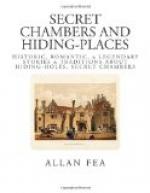[Footnote 1: The principal seat of the Hales, near Canterbury, is now occupied as a Jesuit College. The old manor house of Tunstall, Grove End Farm, presents both externally and internally many features of interest. The family was last represented by a maid lady who died a few years since.]
One or two old buildings in the desolate marsh district of Elmley, claim the distinction of having received a visit of the deposed monarch prior to the mishaps which were shortly to follow. King’s Hill Farm, once a house of some importance, preserves this tradition, as does also an ancient cottage, in the last stage of decay, known as “Rats’ Castle.”
[Illustration: “RATS’ CASTLE,” ELMLEY, KENT]
[Illustration: KING’S HILL FARM, ELMLEY, KENT]
At Elmley Ferry, which crosses the river Swale, the king got aboard, but scarcely had the moorings been cast than further progress was arrested by a party of over-zealous fishermen on the look out for fugitive Jesuit priests. The story of the rough handling to which the poor king was subjected is a somewhat hackneyed school-book anecdote, but some interesting details have been handed down by one Captain Marsh, by James’s natural son the Duke of Berwick, and by the Earl of Ailesbury.
From these accounts we gather that in the disturbance that ensued a blow was aimed at the King, but that a Canterbury innkeeper named Platt threw himself in the way and received the blow himself. It is recorded, to James II.’s credit, that when he was recognised and his stolen money and jewels offered back to him, he declined the former, desiring that his health might be drunk by the mob. Among the valuables were the King’s watch, his coronation ring, and medals commemorating the births of his son the Chevalier St. George and of his brother Charles II.




